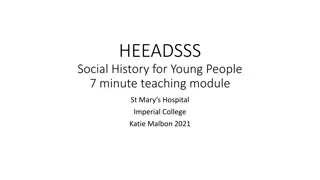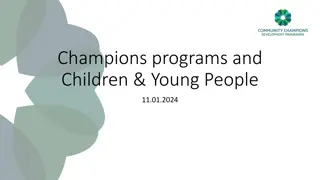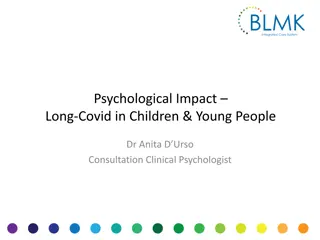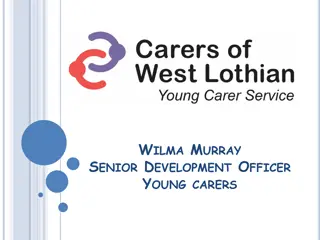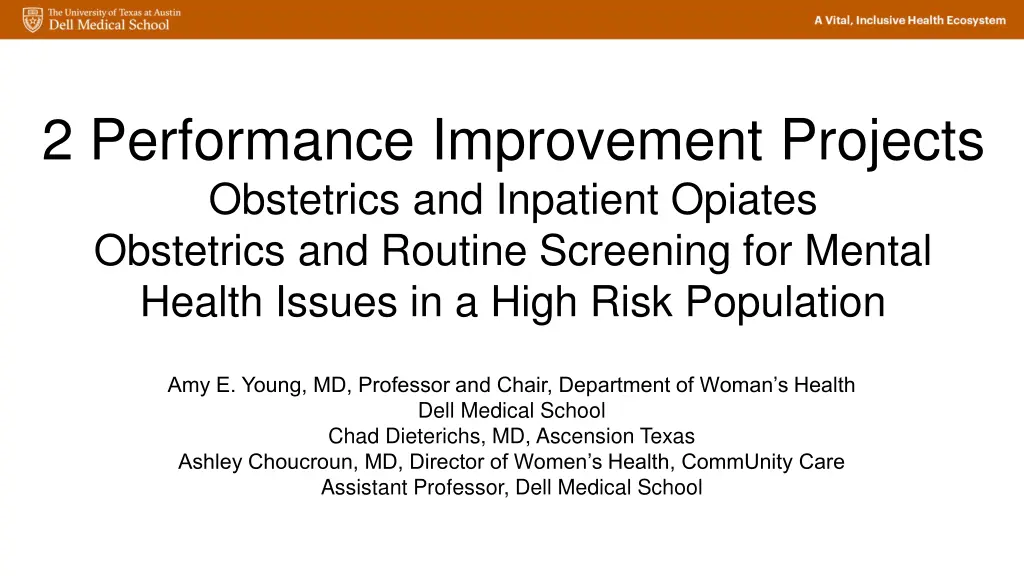
Therapeutic Pain Management Initiatives in Obstetrics and Inpatient Care
Explore performance improvement projects in obstetrics, opiate management, mental health screening, and pain management in collaboration with healthcare professionals at Dell Medical School and Ascension Texas. Discover the top causes of maternal mortality and the evolution of pain assessment techniques towards more functional goals.
Download Presentation

Please find below an Image/Link to download the presentation.
The content on the website is provided AS IS for your information and personal use only. It may not be sold, licensed, or shared on other websites without obtaining consent from the author. If you encounter any issues during the download, it is possible that the publisher has removed the file from their server.
You are allowed to download the files provided on this website for personal or commercial use, subject to the condition that they are used lawfully. All files are the property of their respective owners.
The content on the website is provided AS IS for your information and personal use only. It may not be sold, licensed, or shared on other websites without obtaining consent from the author.
E N D
Presentation Transcript
2 Performance Improvement Projects Obstetrics and Inpatient Opiates Obstetrics and Routine Screening for Mental Health Issues in a High Risk Population Amy E. Young, MD, Professor and Chair, Department of Woman s Health Dell Medical School Chad Dieterichs, MD, Ascension Texas Ashley Choucroun, MD, Director of Women s Health, CommUnity Care Assistant Professor, Dell Medical School
Pain Management Performance Improvement Seton Family of Hospitals - Ascension Texas Department of Women s Health - Dell Medical School
Top Causes of Confirmed Maternal Death: Within 1 Year Following End of Pregnancy
History Overall Ascension Texas Initiative Need to change to functional pain assessment-therapeutic activity goal away from Wong-Baker Faces Rating scale Provided literature for review on current pain management theory Pharmacology and physiology Change in assessment Develop functional pain assessment-therapeutic activity goal for our patients
Therapeutic Activity Goal -Independent walking -Shower and Personal Hygiene -Independent meals Activities of Daily Living -Full Assistance -Non-participation -Bed pan -Assisted walking -Assisted transfers -Bedside commode f -Self directed pain management -Active engagement -Rest comfortably -Interacts with staff and family Psychosocial -Walk on Unit -Walk in Unit Corridor -Walk without assistance -Full Assistance -Bedside Chair via lift -Non- Participation -Dangle at Edge of Bed -Sit in Chair -Stand and Pivot with assistance Mobility
Functional Pain Assessment-Set Therapeutic Activity Goal
Ascension Pain Management Order Set Pilot Graphic of Order Set constant First Dose Second Dose Third Dose 7
Embed new pain regimens in order sets Leave a few alternatives for providers
Change Management Communication /Socialization of procedural change Initiation of process change Process Development Process Education Process Revision Data Knowledge Adoption Communication Data
Comparison Cesarean and Vaginal MME utilization Vaginal Deliveries Cesarean Deliveries
SMCA Delivery DRGs* (June 1, 2016 December 31, 2017) *Delivery DRGs include: 765-768, 774, and 775. 13
Next Steps IRB pending utilizing Superior Insurance information regarding outpatient prescription utilization In process of submitting this to IRB for publication
Acknowledgements Chad Dieterichs, MD, Chair of Pain Stewardship Committee, Ascension Texas Joy Huang, Director Clinical Informatics, Ascension Texas Jamie Moxham, Clinical Effectiveness Manager, Ascension Texas Stephanie Nutt, Value Based Care Analyst, Department of Women s Health DMS Rebecca Rogers, MD, Associate Chair of Clinical Integration and Operations, Department of Women s Health DMS Tom Vetter, MD, MPH, Medical Director of Perioperative Surgical Home Practitioners who utilize our facilities and individual service chiefs who lead this initiative at their sites
CommUnity Care Clinics Ashley Choucroun, Medical Director of Women s Health Services OBSTETRICS AND ROUTINE SCREENING FOR MENTAL HEALTH ISSUES IN A HIGH RISK POPULATION
Findings of Task Force and Goals Current State Fragmented Lack of standardization Centralized/ physician centric
AK Black DMS IPU for Women s Health North Central Pflugerville Runberg Rosewood - Zaragosa Seton Antenatal Testing Unit East Austin Blackstock Oak Hill Southeast Health & Wellness Seton Infusion Center-Gyn Oncology William Cannon South Austin
Prenatal Care-How It Works Low Risk- Community Family Medicine Timing of follow-ups related to risk stratefication and disease process New OB Visit withMD provider at Regional Care Intermediate Risk-RCC MD Trimester trimester First trimester Second trimester St. David's Sterilization HIgh Risk-RCC MD (MFM) Ultrasound for pregnancy dating Evaluation Risk Stratification Mood Disorder Screening Genetic Ultrasound MFM unit Mood disorder screen Anatomic Ultrasound-MFM Unit Preterm birth education Mood disorder screen Contraception counseling Breast feeding counseling Delivery Planning and Education with MD if low risk Seton Medical Center-no sterilization CUC 2 weeks Ongoing preventive health services Screening for Mood Disorders Contraceptive Counseling Integration for ongoing medical management
Integral Care CUC Clinic BHC Inpatient Services
Outcomes Data Overview of data 4/1/2014-4/1/2017 7,400 CommUnityCare OB patients Of those patients, 3,500 were matched with their Seton delivery records 47% match rate
Trimester Entered Care 70% 60% 57% 56% 60% 50% 40% 35% 34% 30% 30% 20% 10% 10% 9% 10% 0% 1st trimester 2nd trimester 3rd trimester 2014-2015 2015-2016 2016-2017
Postpartum Visit Rate 100% 80% 70.0% 68.3% 67.8% 65.5% 65.4% 61.7% 60% 40% 20% 0% Within 21 days Between 21 and 56 days 2016-2017 2014-2015 2015-2016
Postpartum Depression Screening Rate 100% 85.8% 77.5% 73.1% 80% 71.8% 60% 40% 31.6% 27.9% 20% 0% Within 21 days Between 21 and 56 days 2016-2017 2014-2015 2015-2016
Behavioral Health Referral Rate 100% 80% 61.5% 58.3% 60% 38.5% 37.5% 34.3% 40% 26.7% 20% 0% Within 21 days Between 21 and 56 days 2016-2017 2014-2015 2015-2016
Lagniappe Balmi (5-10 days after delivery) Laceration Bleeding How often are you changing pads? Is the bleeding more than a period? If more than a period or more than a pad every two hours bring in. Affect I have blamed myself unnecessarily when things went wrong Yes, most of the time (3) Yes, some of the time (2) Not very often (1) No, never (0) I have been anxious or worried for no good reason No, not at all (0) Hardly ever (1) Yes, sometimes (2) Yes, very often (3) I have felt scared or panicky for no very good reason Yes, quite a lot (3) Yes, sometimes (2) No, not much (1) No, not at al (0) Multiply responses by 3. If the score is >10 bring patient in for a same day appointment. How does your wound/episiotomy look/feel? If severe pain or redness bring in. Milk Are you breast feeding? If the answer is Yes then ask how it is going Is her milk in, how often the baby is feeding and is the baby wetting or soiling 6 diapers daily. If not wetting or soiling 6 diapers or if there is a perception for decreased milk production bring patient in. No - ask about engorgement. (Motrin, cabbage leaves, binder etc). IUD Look to see if the patient had a tubal ligation. If not - ask if she has discussed contraception with her provider and if so what was the method chosen. If it s IUD schedule IUD with postpartum visit?





